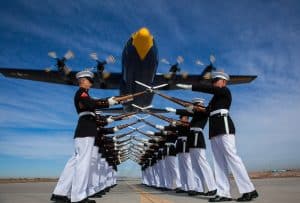In the book The Last Week, Marcus J. Borg and John Dominic Crossan noted that “two processions entered Jerusalem on a spring day.” One was that “Palm Sunday” march we’re familiar with: “From the east,” the authors wrote, “Jesus rode a donkey down the Mount of Olives, cheered by his followers.” But based on their understanding of the historical record, they suggest another parade occurred that same day — one that competed with that of Jesus’s in every way.

Brian Kaylor
“On the opposite side of the city,” the authors explained, “from the west, Pontius Pilate, the Roman governor of Idumea, Judea, and Samaria entered Jerusalem at the head of a column of imperial cavalry and soldiers. Jesus’s procession proclaimed the kingdom of God; Pilate’s proclaimed the power of empire. The two processions embody the central conflict of the week that led to Jesus’s crucifixion.”
“Pilate’s military procession was a demonstration of both Roman imperial power and Roman imperial theology,” the authors added. “A visual panoply of imperial power: cavalry on horses, foot soldiers, leather armor, helmets, weapons, banners, golden eagles mounted on poles, sun glinting on metal and gold. Sounds: the march of feet, the creaking of leather, the clinking of bridles, the beating of drums. The swirling of dust. The eyes of the silent onlookers, some curious, some awed, some resentful.”
Two masters. And we can’t serve both.
Two kingdoms. And we can’t march with both.

Image by skeeze from Pixabay
Will we follow the way of the servant King on a donkey? Or will we follow the vision of imperial violence, the cultic glorification of the powerful ruler, and the heretical theology that might makes right and wealth proves blessings?
Of course, Pilate’s parade would look slightly different today with the sun glinting off more modern metallic beasts of war. The tanks would roll in, the fighter jets would scream overhead, fireworks would erupt in spectacular colors, and devoted fans would carry signs declaring Pilate’s greatness and wave nationalistic banners with golden eagles on top.
Meanwhile, Jesus would be found on the opposite side of the capital city, over on the “wrong” side of the tracks in the neighborhoods of the poor and the minorities. A spontaneous block party might erupt in excitement of his arrival, but the national news would mostly miss it as they raced around Pilate’s parade for the best shot. As usual, the empire seems comfortably in power.
Yet, the Bible includes many warnings about trusting in chariots — or, what those writers today would call tanks or fighter jets. Such militaristic displays are seen as antithetical to trusting in God.
“Some trust in chariots and some in horses, but we trust in the name of the Lord our God,” the psalmist declared in Psalm 20.
Today we face the same basic choice as those in Jerusalem 2,000 years ago. Will we cheer — or at least submit to — the imperial power of the world? Or will we follow the Way of the alternative Kingdom? Which way will we march?
Brian Kaylor is editor and president of Word&Way.
